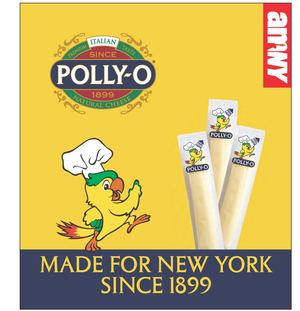
The winter cold can leave people feeling less than inspired about food. The produce in grocery stores is underripe, making it tough and low on flavor, and the general desire to stay curled up on the couch definitely combats any cooking ambitions.
But just because cold winds are blowing in New York City doesn’t mean there isn’t any fresh, local produce to be found. GrowNYC, the nonprofit organization that works to “improve New York City quality of life through environmental programs,” keeps 26 of their greenmarkets open year-round, straight through the bitter winter months.
The markets are stocked with goods from local farmers within a 250-mile radius of Poughkeepsie, NY.
“Twenty-six is not a fixed number — we are always looking for new locations for our greenmarkets and are happy to add more,” says Catherine Crawford, GrowNYC communications specialist. “For a market to continue through the winter, the farmers who sell there must be successful and want to attend.
“We test out year-round products during peak season in an attempt to determine if a market can withstand the winter (when there is less local produce available),” Crawford says.
A walk by the booth for Lani’s Farm at Union Square Greenmarket — GrowNYC’s flagship — showcases hearty winter eats: root vegetables like sweet potatoes, a wide variety of squash like kabocha and Uchiki-Kuri, beets, carrots and parsnips. The vegetables are harvested in October and November and then stored for the colder months. But Lani’s, based in New Jersey, also offers tons of greens — thanks to greenhouses.

“At this time of year, we grow 90 to 95 percent from the greenhouse,” says Tenzing Chime, a farmer from Lani’s.
Keeping the greens from freezing at the market involves generators and tents, plus a "veggie bus" — a trailer that houses greens like Swiss chard, red Russian kale, sorrel and more.
“Every time the weather is below 32 degrees, we bring the bus so it’s easier and it [the produce] doesn’t go bad,” Chime explained.
Windfall Farms from Montgomery, New York, also uses greenhouses, but specializes in small microgreens.
“During the winter, really all we can do is really tiny greens and microgreens, so all this,” farmer Carolyn Paulik said, motioning to the containers of colorful plants, “is grown in heated greenhouses . . . it’s what we can kind of control right now.
“They [microgreens] grow really fast, so we schedule them so we have a little bit to bring to each market on Wednesdays, Saturdays and Sundays. But recently we’ve been getting more of a variety . . . a little bit of everything.”
That variety includes Asian greens, broccoli greens, sunflower greens, purple radish and buckwheat greens, just to name a few.
Menus change with the season
Besides just New Yorkers motivated to make the most of their winter veggies, the market is frequently visited by shoppers and chefs from surrounding restaurants. Wilmier Tavarez, who works for Gramercy Tavern, peruses the stalls for new finds or purchases ingredients for items on the menu that evening.
“That’s our type of restaurant,” Tavarez said. “We cook depending on what’s in season. Everything you see here,” he said while shopping at Lani’s, “you’re gonna see on our menu, like winter squash, parsnips . . . we’re using a lot of apples now too,” which are still found at the market in abundance. “Or celery root, parsnips, rutabaga . . . those are the kinds of things you’ll see [here] after November until like April.”

Tavarez will pick up large sweet potatoes for the restaurant’s Mushroom Lasagna with Kale and Sweet Potato Vinaigrette, and kohlrabi for their Marinated Fluke dish.
Each market day he buys around 30 pounds of produce. “We don’t want to get so much for the whole week . . . we want to keep them fresh,” he said.
Chime works with lots of other chefs from nearby eateries, including Union Square Cafe, Maialino, Untitled, others in the Meatpacking and Chelsea districts and some as far as Brooklyn. All the baby greens he grows are specifically requested by the restaurateurs.
Angel Veza, who works in procurement and sustainability at Manhatta Restaurant, values relationships with the greenmarket farmers, saying they’re like family. “They keep us up to date on what they’ll have available and which produce they’re most excited about,” she said.
Manhatta doesn’t let the limited produce options affect their menu. Instead, they “let the menu evolve organically with what’s in season so that we’re supporting our farmers and serving our guests the best ingredients, Veza said.
“Generally, we’re highlighting a lot of fantastic root vegetables: beets, carrots, parsnips, rutabaga,” she said. “We’ve been getting a variety of fingerling potatoes like sweet potato and Magic Molly fingerlings. They’re beautiful! We’ve also been getting Pink Lady apples and Bosc pears, which are really nice.”
Buying fresh for home kitchens
For those who want to forgo eating these in-season items at a restaurant and instead cook them at home, there are lots of accessible options. GrowNYC offers recipe printouts at their market info booth that highlight seasonal ingredients (this week’s included roasted turnips and carrot and parsnip quiche), and the farmers themselves have their own tips and tricks.

“In the winter I really like to use some of our roots to make a soup, or chili, and then I’ll throw a ton of microgreens on top,” Paulik said. “We can get our winter-warm, hearty meals in and also a good dose of greens . . . they’re a really good soup topper.”
The GrowNYC team also said there are an abundance of “value-added products” (ingredients that are preserved in some way), at the winter markets.
“And that’s a historical way that people have gotten through winter, so it makes sense that you find them in the winter markets,” GrowNYC publicity manager Kathleen Ernsting says. “There are lots of jams, pickled items, etc.”
For example, Lani’s Farm has two women who make all traditional kimchees for the winter, and Windfall (along with many other farms at the market) sells jams made from their summer berry harvest.
It’s also a good time to take notice of the fresh cuts of meats and cheeses available.
“In the summer a lot of people don’t want to be cooking those items because it’s so hot, and there are so many other [produce] options,” GrowNYC publicity manager Amelia Tarpey says. “So it’s a great time of year for that. It’s also what your body is craving.”





































